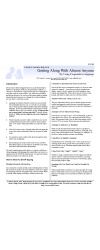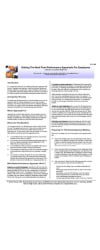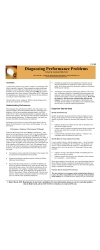Root Causes of Conflict in Work-Groups By Mark Bodnarczuk
Studies have shown that over 85% of the root causes of organizational performance problems are in the structures, systems, and culture within which work-groups are embedded – put good people in bad systems, you get bad performance. Structures and systems are either consciously defined with purpose and intent around a strategic direction as an Intended Culture, or they emerge naturally from the patterns-of-interaction of the personalities of managers and staff within work-groups, departments, and functional units as an Unintended Culture. Unintentionally designed structures and systems that create contention between managers are the single biggest cause of destructive conflict in work-groups. So focusing on conflict in a “work-group” without understanding the structures, systems, and culture within which it is embedded almost guarantees that change will not be sustainable, because the managers and staff within the work-group are less than 15% of the real problem. Identifying the root causes of conflict in work-groups should always begin by asking four key questions:
How much of the conflict within the work-group is being created by the organizational structures, systems, and culture that are outside the work-group
How much of the conflict within the work-group is in response to dynamic forces and pressures that originate from outside the work-group, or from the external environment; e.g., changing levels of revenue, competitors, customer demands, the efficiency of enterprise-wide business processes or functional units that support the work-group, etc
How much of the conflict within the work-group is being created by interacting with other organizational units (or groups outside the organization) that operate from different disciplinary paradigms
How much control can the work-group exert over these factors
The answers to these and other questions will allow you to begin evaluating the root causes of performance issues and destructive conflict that come from outside the work-group in a more systematic and rigorous way. They will enable you to better: a) understand how individual group members with specific personalities are likely to respond when subjected to these external forces and pressures, b) anticipate the kinds of conflict-processing strategies that group members are likely to propose in response to organizational forces and pressures, c) utilize both-and-thinking to decrease the probability of destructive conflict and create better business solutions in day-to-day operations, and d) manage the levels of destructive and constructive conflict between team members to ensure that the climate within the work-group is positive and motivating, rather than negative and counter-productive.
For example, Stephen was the manager of a work-group in a company where he was held strictly accountable for the milestones, deliverables, and the overall performance of his work-group. But Stephen constantly struggled with destructive conflict between two individuals (Sal and Christy) who had radically different approaches to problem-solving on key projects that had high corporate visibility – the basis of Stephen’s compensation. He had tried almost everything to minimize the amount of destructive conflict in the work-group and improve its performance. He has had off-site retreats, done personality testing, and held myriad team building exercises to try to transform the conflict from destructive to constructive. When destructive conflict erupted in meetings, Stephen tried to intervene using the problem-solving tools the group had learned and he tried to discourage this inappropriate behavior by giving Sal and Christy marginal performance ratings and decreased compensation. Stephen had even tried to transfer Sal (the most problematic person) to another department. But each time he tried to take positive steps to correct the situation, Sal and/or Christy went around him to Stephen’s boss Jane who intervened and then reversed some or all of Stephen’s corrective actions. Subsequently, Jane attended one of Stephen’s staff meetings to “set things straight” while Stephen was expected to sit there quietly and say nothing. Jane’s boss does the same thing to her. The Board of Directors does the same thing to the company’s CEO.
As seen in the case of Stephen and Jane, a frequent cause of conflict in work-groups is a lack of well-defined accountability and authority for managers. In the absence of such structure, work-groups will establish their own ways of operating based on individual differences in personality, disciplinary paradigm, intellectual horsepower, political connections, etc. When work-groups, departments, and functional units throughout an organization are informally structured around these criteria, destructive conflict often prevails and aligning or changing the organization’s direction becomes difficult or impossible. As noted by Elliot Jaques, the manager who leads a work-group should be held accountable for a minimum of four things:
The outputs of those who report to them
Creating and sustaining a work-group that is capable of producing the desired results
Providing leadership for direct reports so they collaborate with the manager and each other to achieve the work-group’s goals
Adding value to the work of their direct reports
The issue of destructive conflict that results from differences in personality is most related to the third element in the above list. But even a complete understanding of the work-group’s personality differences will never eliminate destructive conflict without the implementation of the other elements of both accountability and authority. In Stephen’s case, he had accountability without some of the authorities listed below. Jaques argues that in order for a manager to be successful, they must have at least four basic authorities. This includes the ability to:
Veto the appointment of new people to the work-group
Decide on the task assignments of direct reports
Conduct performance appraisals of direct reports and reward desired performance and discourage poor or inappropriate performance
Initiate the removal of a direct report from their role in the work-group
No amount of teambuilding or personality profiling will ever transform Stephen’s situation into constructive conflict without accountability and authority. To the degree that these accountabilities and authorities are missing, to that same degree work-groups like Stephen’s are forced to establish their own ways of operating based on individual differences in personality, disciplinary paradigm, intellectual horsepower, and political connections. One of the main reasons that traditional approaches to using individual personality typologies in the workplace have often produced marginal (or failed) results in terms of long-term sustainable change, is because they have focused on the local causes of personality in individuals, without addressing the common causes of organizational structures, systems, and culture. In other words, traditional approaches to using personality type in the workplace fail to view Personality in Context.
Once the root causes of destructive conflict are distinguished and then identified as either common or local causes, it’s important to understand the four ways in which the patterns, structure, and dynamics of conflict actually work in organizations. This includes:
Level 1 (Organizational Conflict): Two or more work-groups, departments, or functional units experience destructive conflict caused by: a) the structures, systems, or culture, b) differences in disciplinary paradigms and sub-cultures, or c) the personalities of the managers (Border Guards) who lead these organizational units and this negatively impacts the climate and performance of the interacting units and the larger organization. Often this kind of destructive conflict optimizes the power position and performance of one organizational unit, and sub-optimizes the overall performance and effectiveness of the entire organization.
Level 2 (Work-Group Conflict):The work-group experiences destructive conflict with the structures, systems, culture, or with an individual manager or staff member outside the work-group which negatively impacts the group’s climate and performance.
Level 3 (Interpersonal Conflict): People in small-groups of 2s, 3s, and 4s experience destructive conflict with each other which negatively impacts the climate and performance of the work-group.
Level 4 (Intrapersonal Conflict):An individual experiences destructive conflict within themselves that may, or may not, be created by work-group or organizational activities, but this conflict negatively impacts the climate and performance of the work-group and the organization.
The first two levels of conflict are most often catalyzed by the organizational structures, systems, and culture. The second two levels are most often caused by the personality and level of psychological health of the individuals involved. It’s important to remember that in many situations, all four levels of conflict are happening together at the same time, which is what makes dealing with destructive conflict in the workplace so difficult. When destructive conflict at all four levels persists over time, it can go on autopilot and become habitual patterns-of-interaction that frustrate and undermine organizational and individual performance. As a general rule, in the absence of well-defined structures and systems, patterns-of-interaction driven by personality will rule and dominate the day-to-day realities of organizational life.
Mark Bodnarczuk is the Executive Director of the Breckenridge Institute, a research center for the study of organizational culture based in Boulder, Colorado. He is an author, researcher, consultant, teacher, and facilitator with more than twenty years of experience working with companies in the area of high-tech, basic and applied research, pharmaceuticals, health care, retail as well as government and non-profit organizations. Mark has published widely in the areas of corporate culture and leadership development and is the author of two books, Diving In: Discovering Who You Are In the Second Half of Life and Island of Excellence: 3 Powerful Strategies for Building Creative Organizations. He has a BA from Mid-America University, an MA from Wheaton College, and an MA from the University of Chicago.
Mark can be contacted at:
Breckenridge Institute
PO Box 7950
Boulder, Colorado 80306-7950
http://breckenridgeinstitute.com/





